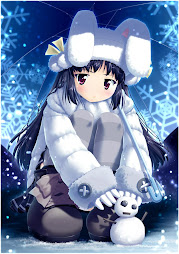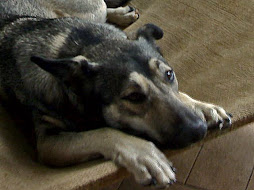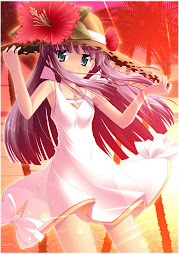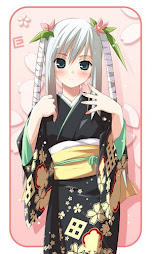About Me

- MJ
- Brisbane, QLD, Australia
- Full Time Student Queensland University of Technology. Bachelor of Health Science (Public Health) and Bachelor of Creative Industries (Media & Communications). This blog has been created specifically for a uni assignment in Virtual Cultures (KCB201). **** By the way I'm currently looking for Medical students interested in working with people suffering from Eating Disorders for my work in the health field. As you can see I love Anime and am looking for both Anime/Magna artists and Claymation artists for a feature film and TV series for my work in Creative Industries. You don't have to be a QUT student or a student at all but preferably live in Brisbane. View complete profile for contact info.
KCB 201 Blogging Thoughts

www.quizilla.com
snow girl

Anime Crying Girl

www.gamestv.org/event/4811-heroes-vs-panzerclan/
Wednesday, May 14, 2008
The (Virtual) Culture of Anime
Sunday, May 11, 2008
Web 2.0, Part 2.
Web 2.0 views and understands the internet as platform. There is more innovation and collaboration today than even just one year ago as a result of the introduction of Web 2.0/social software. It is being utilised by mainstream business in a way that was unthinkable only a few years ago, enabling greater efficiency, problem solving and better communication. As O'Reilly (2008) states :
"Everyone understands that this is the new game, not just something for consumer startups. Everyone in the computer industry, everyone in mainstream business, needs to learn the new rules, exploit the new opportunities, and help to invent the future. This is a better time to be an internet entrepreneur than in the giddiest moments of 2006 and 2007."
Friday, May 9, 2008
Review on Produsage Blog
User-led content production, creation, development and manipulation occurs in a wide variety of contemporary, online environments. Some of the most popular Web 2.0/social software domains driving the new hybrid form of simultaineous production and usage (i.e. "produsage") are explained and illustated below. Most of these are free to access and actively engage in. The paridgim shift from industrial-age to informational-age ideas and collaboration has profoundly transformed social, economic, political and media frameworks forever.
Social Networking: Social networking is at the core of virtual cultures and of course, the driver of social software development. Basically social networking refers to the grouping of individuals into specific groups who collaborate, share and exchange information, knowledge or creative ideas. In the real world social networking may take place in or between small rural communities, large cities, neighborhoods, schools or any place where a group of people interract. In the context of virtual cultures, social networking involves online communities where members of a group or community may be geographically dispersed throughout the world but are able to interract on a website, via the world-wide-web. Unlike "real" world cultures and communities such as schools, universities or workplaces, the internet is accessed and viewed by millions of individuals who are looking to meet people with similar interests and develop new friendships or business relationships.
Examples of popular social networking URL's include:
- Myspace - an online community that allows friends to keep in touch and meet new people... Once you sign up, you can customize your profile by adding information about yourself, listing your interests, hobbies, and educational background, and uploading photos of yourself and your friends. You can also create your own blog for others to read.
- Facebook - Facebook is a social networking website originally marketed to uni students, but has grown so much it is now open to anyone 13 years of age or older. Like Myspace, facebook users can create and customize their own profiles with photos, music, videos, and information about themselves. Friends can browse the profiles of other friends, write messages on their pages and share music, videos and photos.
- LinkedIn - LinkedIn is a business-oriented social networking site mainly used for professional networking. Registered users are able to maintain a list of contact details to make it easy to contact and network with people they know and trust in business. People on this list are known as "connections" and users can invite or request anyone (both other LinkedIn, and non-LinkedIn members) to become a connection.
- del.icio.us - Del.icio.us is a community bookmarking website where users can save web page links of personal interest and share them with other users. A users' bookmarks are made public so other people can find good web pages by searching other users' bookmarks. Users bookmark a wide variety of web pages including links to news articles, scholarly journals, "how to" sites and favourite websites. Del.icio.us keeps track of how many people bookmark each site and posts the most popular website links on its home page. This helps users to find websites on particular topics which are usually of a high quality.
- Blogger - Blogger is just one of many sites which enable and host weblogs. A weblog refers to a personal or public web page which contain a list of posted journal entries, photos, picturs and links to other weblogs and sites. Anyone with basic web skills such as uploading images and creating links can publish their own blog. Some weblog hosts such as Blogger have made it even easier by creating and providing an interface where users can simply type a text entry and hit "publish" to publish their blog. Due to this simplicity many people both young and old have established a presence on the Web. People now can share their personal thoughts and experiences with thousands of people around the world. Blogs are can be updated daily, weekly or monthly and shut down at any time. The term "blog" may also be used as a verb, for example to blog means to write and post an entry on your personal weblog page or to comment on/respond to a post someone elses blog page.
- Google Maps - Google Maps is a free web mapping service application and technology provided by Google. It offers street maps similar to a traditional refedex, a route planner, and an urban business locator for many countries and cities around the world. Google Earth, a similar but independent program (also provided by Google), offers enhanced, detailed map-viewing features on a global scale.
Creative resource outlets: Many social networking sites have been established for the purpose of sharing creative ideas and outcomes. They provide artists with place/space to showcase their work and gain exposure on a world-wide scale. The general public can view and even post their own creations and ideas to share with others. These sites act as a resource library where users can not only view but also upload and save then manipualte, mash-up, change, recycle and re-use the creative resources.
Examples of popular creative resouorce outlets URL's include:
- You Tube - YouTube is a video sharing website where users can upload, view and share video clips. Registered users are able to upload an unlimited number of videos and unregistered users can watch most videos on the site. There is an 18+ age restriction on some videos (e.g. those containing potentially offensive content) but the majority are available for viewing by the general public audience. Videos are usual only available for viewing for a certain period of time. The uploading of videos containing pornography, nudity, defamation, harassment, commercial advertisements and material encouraging criminal conduct is prohibited on You Tube. Similar and related videos, determined by title and tags, appear onscreen to the right of a given video so the viewer can easily access them. The user can also post video 'responses' and subscribe to content feeds.
- Flickr - Flickr is an image and video hosting website and online (virtual) community platform initially developed by techno-company Ludicorp and now owned by Yahoo. Flickr was one of the earliest Web 2.0 applications and has grown to host over 2-billion images. In addition to being one of the popular web sites for sharing personal photographs, Flickr is widely used by bloggers as a photo repository. Its popularity has been fueled by its user-friendly organization tools, which allow photos to be tagged and browsed through the practice of folksonomy.
Gaming: Gaming in relation to virtual cultures and produsage refers to games played on a computer network. These days this usually involves being online (on the Internet) although electronic games were around long before the internet. Previously they were played using modems and hard wired computer terminals. The explosion of online gaming communities is a result of the overall expansion of computer networks from small local networks to the Internet. Online games can range from simple solo games based on the traditional such as tick-tack-toe, memory or crosswords, to elaborate games incorporating complex graphics and virtual worlds which can engage many players, on a global scale, simultaneously. Some games such as Second Life and The Sims can virtually transport the player into a new world where they can adopt a whole new identity and life. Online gamers can become part of a community or culture made up of people interested in the same game, who can interact and compete without ever meeting face-to-face.
Examples of popular gaming URL's include:
- Second Life - Second life is a virtual world in which the user can adopt a whole new identity, becoming a different person virtually living in a different life. It provides for creativity, collaboration, commerce, and entertainment and is inhabited by millions of virtual residents from around the globe. The ability to reinvent one’s identity and create an ideal lifestyle in a virtual environment has become a popular phenomenon amongst gaming cultures, and it is no wonder. “Don't bother with a suitcase - everything you could possibly want is obtainable here. But be sure to bring your imagination: Second Life is a world of endless reinvention where you can change your shape, your sex, even your species…” Wired (2006). All creations within Second Life are protected by Intellectual property rights in the online environment, just as they would be in the “real” world. Characters can own, buy and sell almost anything, participating in and contributing to an online economy similar to real life. Second Life users also interact as their “true” selves through the Second Life blog. Blogging (as defined above) is another example of a virtual, social-networking culture.
- The Sims - A similar concept to Second life, The Sims is a strategic life-simulation computer game. Basically it is a simulation of daily activities "lived" by one or more virtual persons (known as "Sims") in a suburban household near SimCity. Since its initial release it has become so popualar that seven expansion packs and a sequel, The Sims 2 (with its own expansion packs), have been released. Another sequel, The Sims 3, is currently under production. The Sims has won numerous awards, including GameSpot's "Game of the Year Award" for 2000. Unlike most other computer games where goals and objectives are definitive and have a begining and and end, The Sims encourages the player to make choices and engage fully in an interactive environment. The only real objective of the game is to organize the Sims' time to help them reach personal goals. Players are encouraged to make their own characters, however certain pre-made characters, such as the Newbie and Goth family, are available and have become popular.Creating a Sim consists of creating a virtual "family" with up to eight members who just as in "real" life are identified by a last name. The player can then provide each family member with a first name and optional biography, and choosing the sex (male or female), skin complexion (light, medium, or dark) and age (adult or child) of the Sim. Each Sim is characterised by five attributes and a specific head and body (which includes a specific body physique and clothing). The player cannot change a Sim's face, name, or personality once they have been moved onto a lot.
Regardless of how many members are in a family, the player starts with §20,000 cash for either the purchase of a house or vacant land to build a house, and purchase furniture. Over 150 home building materials and furnishings for purchase.
Sims are instructed by the player to interact with objects, such as a television set a bike or a piece of furniture and are directed to interact with other Sims which helps them develop a healthy social life and gain popularity. Sims may receive house guests but the player cannot control 'visiting' Sims. When enabled by the player, Sims have a certain amount of free will, meaning they will engage in activities when left to their own devices, though player commands will override anything a Sim decides to do on its own. However, sims may not perform important commands, such as find a job or conceive a child. Unlike the simulated environments in games such as SimCity, SimEarth, or SimLife, the Sims are not fully autonomous. They are unable to take certain actions without specific commands from the player, such as paying their bills. Thus, if left alone, without any player direction, the Sims will eventually develop overdue bills and their property will be repossessed. Since the player makes decisions about allocation of time to daily activities such as exercise, personal hygine, intellectual development, sleeping, eating etc. if they fail to instruct their Sims (simulated humans) they will suffer consequences. Just as in real life, if they don't eat they will die of starvation, if they do not exercise they will become overweight and unfit, if they do not go to the bathroom, they will wet or soil themselves and if they do not interact with others they will become depressed and antisocial. When Sims are neglected and fail to maintain their physical and mental health they are more likely to be nasty to other Sim characters by insulting them or attacking them. Financial responsibility is also simulated through instructing the Sims to find jobs, go to work, pay bills, and take advantage of personal development and social contacts to advance in their jobs. The daily choices and instructions the player assigns to each Sim ultimately leads to the creation of either a large, healthy, functional family or a lonely, unhealthy life.
Citizen Journalism: Citizen Journalism presents somewhat of a threat to traditional industrial journalism as it recrutes and employs everyday users to commentate and report on news and journalistic material. In general, citizen journalism represents the people and enabless a democratic voice on social, economic, and political issues. It provides and outlet for debate, collaboration, contribution, opinion, updating and general public conversation on the most relevent, important and useful information affecting the world, different societies or specific communities.
Examples of popular Citizen Journalism URL's include:
- Slashdot Slashdot is a news website origonally created by Rob Malda, now owned by SourceForge, Inc., which focusses mainly on techno-related issues. Its "produsage" identity comes from being characteristically a user-driven news and current-affairs site, although submissions are editor-evaluated and can be rejected prior to posting. Each story is linked to an Internet forum-style comments section for general viewing or contribution. Though the site was established prior to the modern concept of the weblog, Slashdot's layout and function is commonly compared to a blog.
- Indymedia - Indymedia, short for The Independent Media Center (IMC), hosts a global-scale network of journalists who partcipate in reporting on political and social issues. While taking a left-wing perspective, Indymedia is an open publishing and democratic site which allows anyone to contribute. The network originated through its close ties with the global justice movement, which criticizes neo-liberalism and its associated institutions. Indymedia was an initiative established to provide an alternative to government and mainstream media. The network's motto: "Indymedia is a collective of independent media organizations and hundreds of journalists offering grassroots, non-corporate coverage. Indymedia is a democratic media outlet for the creation of radical, accurate, and passionate tellings of truth." The site is multilinguistic.
- Ohmynews - OhmyNews is a South Korean online newspaper, which is thought to have been the first to accept, edit and publish articles from its readers in an open source style of news reporting. Their motto: "Every Citizen is a Reporter" reflects the site's democratic standpoint. The site's 55 staff members account for around 20% of its content, while the remaining articles are written by freelance contributors from the general public.
Knowledge bases: Online knowledge bases are fast replacing traditional hard copy autoritarian compiled information resources such as Encyclopedia Britannica, The Oxford English dictionary and other multilingual dictionaries and traditional hard-copy maps and atlases. The benifit of this is that information can be easily updated and added to and is more readily available. However the downside is that content which has been contributed to by the general public may not always be accurate, true or of quality standard, although as Jim Giles (Nature - International Weekly Journal of Science) found, some studies suggest that its content quality may be on a par with that of its corporate competitors. This claim has been refuted in an article by Encyclopedia Brittanica - 'Fatally Flawed: Refuting the recent study on encyclopedic accuracy by the journal Nature.'
Examples of popular knowledge base URL's include:
- Wikipedia - Wikipedia is a free online encyclopedia created through the collaborative effort of a community of users. Anyone who accesses the site can edit it and those who are registered on the site can create a new article for publication. The name Wikipedia is derived from the prefex wiki , a server program that enables anyone to edit web site content through their web browser, and adapted from the word encyclopedia meaning a rounded eduacation or general knowledge. The wikipedia (and the wiki concept in general) is a prime example of produsage. Wikis invite all users to edit any page or to create new pages within the wiki website, using only a plain-vanilla web browser without any extra add-ons. They provide meaningful topic associations between different pages with page links dispersed throughout, enhancing the viewing experience and extending it to create an endless information on almost any subject. A wiki is not a completed resource site created for view-only visitors. Instead it seeks to involve the visitor in an ongoing process of creation, contribution, collaboration and editing which results in a constantly changing webpage and site. Documents within a wiki can be written in simple markup language using a web browser. A single page on a wiki website is referred to as a "wiki page", while the entire collection of pages, which are usually well interconnected by hyperlinks, is "the wiki". This is essentially a database for browsing and searching through information for use, making contributions, collaborating and publishing new information.
The ease with which pages can be created and updated is a defining characteristic of wiki technology. Generally, there is no review before modifications are accepted and many wikis are open to alteration by the general public without requiring them to register user accounts. This means edits can be made in real-time and appear online instantly. This is one major downfall of the system as it can facilitate unintentional mistakes, intentional mis-use and outright abuse. Some wikis attempt to avoid or minimise this by employing manned surveillance or setting up private wiki servers which require user authentication to edit pages, and sometimes even to read them. For a greater understanding of the wiki see Ward Cunningham and Bo Leuf's book on the subject: The Wiki Way: Quick Collaboration on the Web.
- Wiktionary -Wiktionary is a multilingual, web-based, free content dictionary, available in over 151 languages. The term Wiktionary is portmanteau of Wiki and dictionary however unlike other projects created by the Wikimedia Foundation, this word contains only a portion of the prefix "wiki". Unlike standard dictionaries, (and following the trend of it's sister site Wikipedia, above), Wiktionary it is written collaboratively by volunteers using wiki software, allowing articles to be changed by almost anyone with access to the website. This characteristic alone categorises wiktionary as a produsage site. Since Wiktionary is not limited by print space considerations like traditional hard copy dictionaries, most of its language editions provide definitions and translations of words from many languages. Some language editions also offer additional information typically found in Thesauruses and lexicons. The English version of Wiktionary includes Wikisaurus (another member of the Wikimedia Foundation's wiki family) which as the name suggests acts with the same function of a thesaurus.
Friday, May 2, 2008
Online Communities/Social Networking - The Destructive Side
Continuing on from yesterday's debate on 'Anorexic Online Communities'...... These are examples of an extremely NEGATIVE, DESTRUCTIVE, DANGEROUS, SAD use of Web 2.0/online communities/social networking...... If you want to see how destructive these websites are you just have to look at the titles of the websites:
- Anorexic Web Welcome to the Anorexic Web http://www.anorexicweb.com/
- How To Become Anorexic There is a right and a wrong way in how to become anorexic. Here are my anorexic tips. http://www.pro-anorexia.net/How_To_Become_Anorexic.html
- How to be anorexic to have Weight Loss This website is dedicated to: Learn how to become anorexic with all means like: Anorexics, supplements, activity, vegetables, caffeine, ... http://www.health92.com/
- Ways To Become Anorexic. Click here now! Ways To Become Anorexic! Ways To Become Anorexic. Click here now! Ways To Become Anorexic! ... Turn Anorexic PRESS RELEASE Continuing Professional New York Vioxx ... http://learn21.com/Messages/10803.html
Make up your own mind but if you believe these sites to be justified (even in terms of provide education to health professionals working with people with eating disorders) you are very ignorant (or else you have severe eating/body image disterbances yourself).
Thursday, May 1, 2008
Comment on Anorexic community sites
It is my response to a posting I found on kcb201 - n5681065 's blog...... Wednesday, April 9, 2008 which said......
How do online communities organise themselves?
"Firstly, it is probably important to consider the question: why do online communities organise themselves? Put simply, there are so many people and so much material on the internet that it is impossible to utilise it all. So how do we make use of the availability of what and who is most useful to us?Someone I know, who works in nutrition, recently said to me that the fact that the internet has provided a space for all sorts of "thinspire" and "pro-Anna" groups is not actually such a bad thing. He claimed that it provided a space a group of our community, who are often isolated, to feel connected once again. As a result it also provided a space where the problems faced by the individuals were put on the table. The truth and honesty that comes out of such a virtual community may actually assist professionals treating eating disorders to properly understand what they are dealing with.
In response Mary Jane (that's me) said...
This post made me SICK!!!! Sorry, the majority of it is good, but the comment about online Anorexic "thinsiration" groups being a good thing is an absolute OUTRAGE. I have suffered from chronic Anorexia for 21 years(since I was 13, I am now 34) and I think these sites are disgusting! One of my major reasons for studying Media and Communications is to find a solution to be able to have these websites shut down. If these websites had have been around when I was 13 I know I would have used them to make myself even sicker than I was and considering I have almost died several times I would probably be dead. I guarentee these sites have contributed to deaths - Anorexia is an insanely complex disorder and HAS to be taken serioiusly!!!! It CANNOT be seen as a "lifestyle choice" as these sites profess - it is a deadly and desperate illness - with the highest mortality rate of any mental illness - and those girls who call it a lifestyle are very sick. I know this because I was one of them and I am now in the later stages of recovery - I lived in the depths of the illness for 20 years - I look back and see how distorted and irrational my thoughts were when I was in the depths of extreme malnutrition - your brain just doesn't function normally. For a nutritionist to say these sites are good makes my blood boil!! I am the FIRST to tell you how EXTREMELY ISOLATING and LONELY anorexia is, but these sites are NOT the solution!!!! Creating a "community" for anorexics just enocourages the illness - I know that the hundreds of hours I have spent in hospital wards specifically for people with eating disorders made me MUCH WORSE. Since the age of 21 I decided I would never go back to those eating disorder clinics and have been treated in general medical wards for the past 13 years. While neither of these treatment options were adequate, being around other people with eating disorders was actually counterproductive - we never encouraged or talked about how to get better - it was all about how to deceive nurses and doctors and how to lose more weight. These sites do the same thing for girls not in hospital - they share tricks for deceiving parents and friends about how much they are eating, talk about how much exercise they should be doing and teach each other how to throw up... and BELIEVE ME, when you are that sick you will do ANYTHING to be just that bit thinner - even when you are on death's door. People who suffer from Anorexia are characteristically very high achievers and competitive by nature - communities such as these only encourage competition to be the thinnest and the sickest - something I know I always felt a need to achieve even if it killed me. In addition to Media and Comms I am studying Public Health and it is my BIGGEST goal to set up an Eating Disorders treatment centre here in Brisbane - with a totally new approach from the perspective of someone who knows all the "tricks" and reasons why these girls are so hard to treat. After 20 years of searching for a treatment program which actually HELPED me rather than making me WORSE I know how DESPERATELY NEEDED this is. I have worked with more dieticians/nutritionsts than I could count and admittedly, when you are in the depths of anorexia it is quite pointless to see them..... Anorexics know more about calories and fat etc. than most nutritionsts - it is a TOTAL OBSESSION. When you are THAT driven to lose weight NO advice from a dietician is going to make you eat... The issue is NOT needing to know what to eat - Anorexics know what they SHOULD eat, they are just ABSOLUTELY PETRIFIED to do it - SERIOUSLY, it feels like someone is trying to force you to eat POISON!!!! - THAT is HOW SCARY food feels....... You can tell that nutritionist he can talk to me if he wants to learn more about the illness - PLEASE DON'T accept that girls are KILLING themselves just for your educational benefit. I am very, VERY SAD and disheartened to have heard that someone (especially in such a profession as nutrition) could possibly take that attitutude!!!! VERY IGNORANT!!!! MJ
Wednesday, April 30, 2008
What is web 2.0?
Collins (2007) also compares and contrasts the differences between 1.0 and 2.0, highlighting that:
“Knowledge worker 1.0 are forced to look like this:
· limited location
· limited roles
· inside the wall
· stuck at a desk (and stuck using email and other standard tools)
· custodian of information
· knowledge as process
· uses rigid ways of organizing information
In contrast:
"Knowledge Worker 2.0 looks like this:
· all over the organization
· broad skills on solid base
· not bound to one place
· connects with colleagues, peers and client community everywhere
· Understands “the way we do things around here”
· Uses many different tools
· No particular age
· Knowledgeable, interested, engaged, contributing
· Shares and distributes information freely
As discussed in lecture 2, O’Reilly (2005) explains in detail the differentiation between expert knowledge (1.0) and user-driven knowledge (2.0). He uses many examples such as Google, Ebay, Amazon, Wikipedia, Del.icio.us, Flickr, Linux and Folksonomy (in contrast to taxonomy) to illustrate how “network effects from user contributions are the key to market dominance in the Web 2.0 era” (O’Reilly, 2005, 2).
This is a comprehensive article which uses an enormous range of examples to explain and illustrate the differences between and significance of web 2.0 as opposed to 1.0. In addition to those mentioned above, these include RSS feeds, blogging, Netscape, podcasting, AJAX, JavaScript, XHTML, and the list goes on. Each of the examples explored in the article demonstrates one or more of the key principles, or what O’Reilly (2005) believes are the “core competencies, of Web 2.0 companies.” These are:
· Services, not packaged software, with cost-effective scalability
· Control over unique, hard-to-recreate data sources that get richer as more people use them
· Trusting users as co-developers
· Harnessing collective intelligence
· Leveraging the long tail through customer self-service
· Software above the level of a single device
· Lightweight user interfaces, development models, AND business models”
(O’Reilly, 2005, 5)
Saturday, April 26, 2008
What is Produsage?
So what is produsage you ask? In his own paper 'Produsage: A Working Definition' Bruns explains produsage as "the collaborative and continuous building and extending of existing content in pursuit of further improvement."
As one of Axel's students, my understanding is that he invented the term 'produsage' to explain the way in which the internet has opened up opportunities for everyday people to become producers as well as users. No longer is society divided into those who produce (an end product) and those who consume. The internet and Web 2.0 have transformed society from being a property and material "things" based ecomomy (brought about by the Industrial Revolution) into an information and knowledge based economy. This has enabled a participatory environment where the product is neither tangible nor complete. Information and knowledge are shared, changed, edited, adapted, recycled and re-used on an even platform. While this is the essence of the term produsage, it becomes more complex when discussing its relationship to many other internet based terms.
The word produsage can be a little ambiguous in some situations, for example Ebay and Amazon.com - you can participate by buying and selling, but are you really "produsing" in the proper sense of the word. Well let's take a look at the pre-requisites for being an environment of produsage:
As Axel explains in much of his work, there are 4 key principles or "pre-conditions" neccessary to qualify a technosocial environment as produsage. These are:
- Open participation and communal evaluation
- Fluid heterachey and Ad Hoc Meritocracy
- Unfinished artifacts in a continuing process
- Common property with individual rewards
Axel is "the" expert on produsage. After all, he did invent the term and he has written many articles on the topic. So if you are really into virtual cultures/social networking/Web 2.0 and want to know more, be sure to check out his blog, his website produsage.org and his new book!





